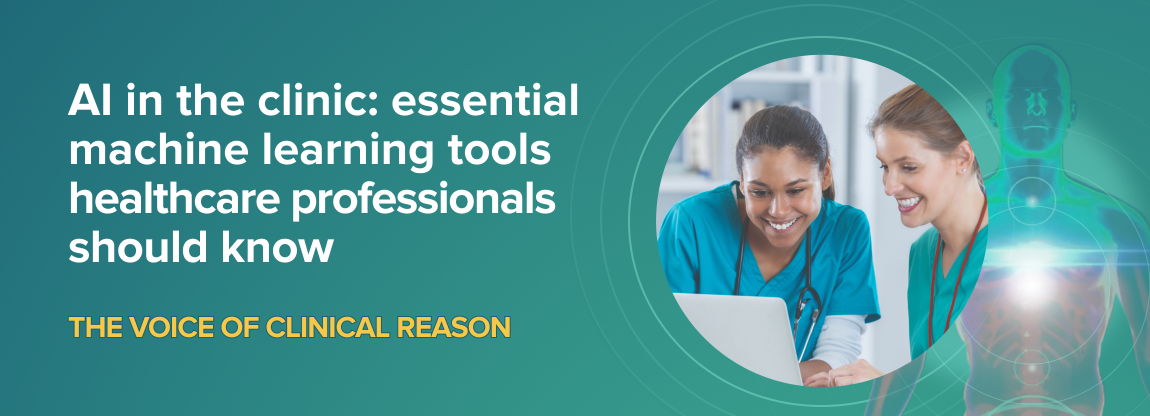AI in the clinic: 6 essential machine learning tools healthcare professionals should know
Artificial intelligence has become more than a buzzword in medicine. It’s here, working alongside clinicians in ways that were nearly unimaginable a decade ago. From interpreting diagnostic images to generating personalized treatment recommendations, machine learning is increasingly woven into the fabric of clinical decision-making.
Yet, for many physicians, the terms "machine learning" and "AI" still feel like the domain of tech specialists, not something to be mastered on top of a full patient panel. The good news is that you don’t need to be fluent in code to get the most out of these tools. What matters is understanding the core models powering these technologies. Clinicians equipped with this foundational knowledge are better prepared to collaborate, evaluate, and apply AI-driven tools to provide even better care for their patients.
Chapter 501 of the upcoming 22nd edition of Harrison’s Principles of Internal Medicine provides a physician-first lens into the evolving role of AI in clinical practice. It introduces key machine learning tools clinicians are likely to encounter, along with the concepts needed to understand them. In this article, we explore six of the most impactful models and how they’re already shaping care.
1. Linear and logistic regression
Still vital in the AI age, these traditional statistical models establish relationships between clinical predictors and outcomes. Whether estimating the probability of a stroke or predicting treatment adherence, regression models are interpretable, familiar, and often perform on par with more complex models in well-curated datasets. They’re also the benchmark for comparison—understanding how newer models work often begins by anchoring them to this trusted, foundational standard.
2. Gradient-boosted trees
Think of these as a smarter forest of decision trees. They combine multiple models into a powerful ensemble that’s optimized to make accurate predictions in complex datasets, especially when there’s no inherent order or sequence. This makes them particularly effective for handling structured clinical data, such as calculating patient risk scores or flagging anomalies in lab values, offering both speed and precision in decision-making.
3. Convolutional neural networks (CNNs)
CNNs specialize in interpreting images. Their architecture mimics how the human visual cortex processes visuals, making them the go-to for radiology, dermatology, and pathology applications. They’re the brains behind algorithms that can, for instance, flag lymph node metastases in breast cancer or detect diabetic retinopathy from retinal scans. These models are capable of spotting patterns that even expert eyes might miss consistently, though they still require clinical oversight to verify findings and guide decisions.
4. Transformer models
The engine under the hood of ChatGPT and other large language models, transformers are designed to process and generate human language. In medicine, they’re showing potential in everything from summarizing clinical notes to helping generate differential diagnoses. For example, a clinician typing in a complex symptom set may receive a model-generated list of possible diagnoses for consideration. These tools are not replacements for clinical reasoning, but they can serve as powerful brainstorming partners that broaden diagnostic thinking.
5. Latent diffusion models
These generative models can synthesize realistic data, such as medical images or notes, from random input. While still emerging in clinical contexts, they hold promise for generating synthetic datasets that support medical training and research while protecting patient privacy. By filling data gaps, particularly in underrepresented populations, these models are helping accelerate AI development in a more inclusive and responsible way.
6. Transfer learning
Imagine training a model on general data, like everyday images, and then fine-tuning it for something highly specific, like classifying skin lesions. That’s transfer learning. It allows developers to adapt existing models for new, domain-specific tasks, saving both time and resources. In clinical settings where labeled medical data are limited, this approach improves model accuracy and makes AI more accessible for niche specialties and smaller datasets.
Bringing it all together
Machine learning is not magic. It is math, data, and code, all used in service of better care. But, as these tools move from the lab to the clinic, physicians don’t need to become data scientists. They need conceptual fluency. Knowing what each model does, where it shines, and what its limitations are is key to making informed decisions about adoption and use.
Building AI awareness is part of evolving as a clinician, not drifting from it. It strengthens how we think, diagnose, and care.
Your next step
As these tools move from the lab to the clinic, clinicians need fluency—not in code, but in concepts. Chapter 501 of the 22nd edition of Harrison’s Principles of Internal Medicine, ‘Augmented Intelligence and Machine Learning in Clinical Medicine‘, offers a clear and practical roadmap for navigating the exciting world of AI in medicine.
Pre-order your physical copy to explore the full chapter and go deeper into the models transforming care. As AI becomes part of everyday practice, it’s the clinician’s insight and judgment that give it meaning and impact.
There are now two ways to access Harrison's:
- Order your physical copy online
- Explore the full edition of Harrison's and more with AccessMedicine - available via institutional access or free trial.

